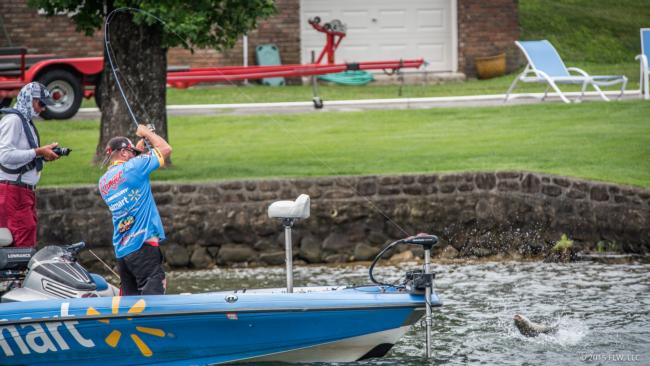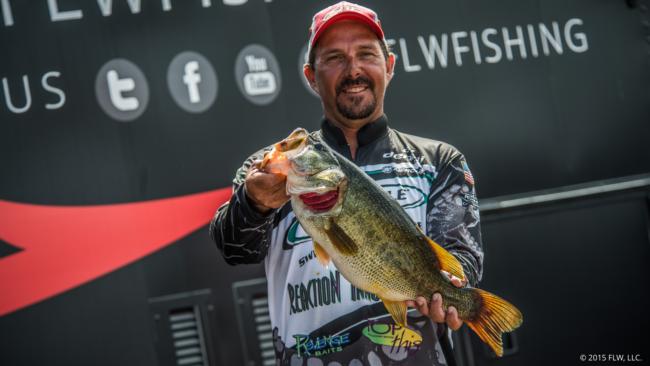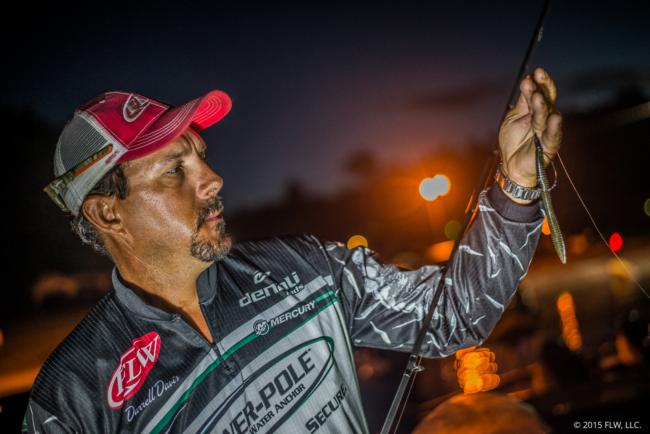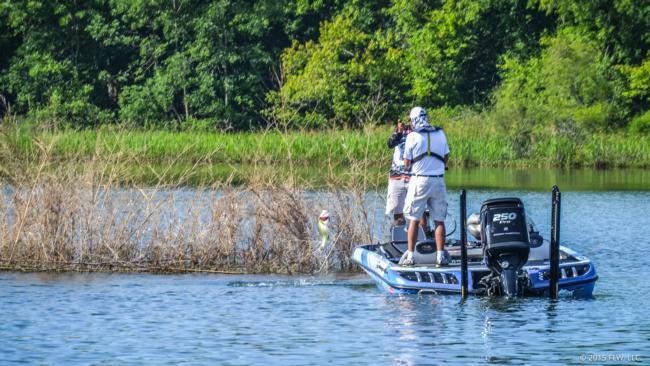Shallow Patterns from Chickamauga
Ledge fishing wasn’t the only way to catch Tennessee River giants
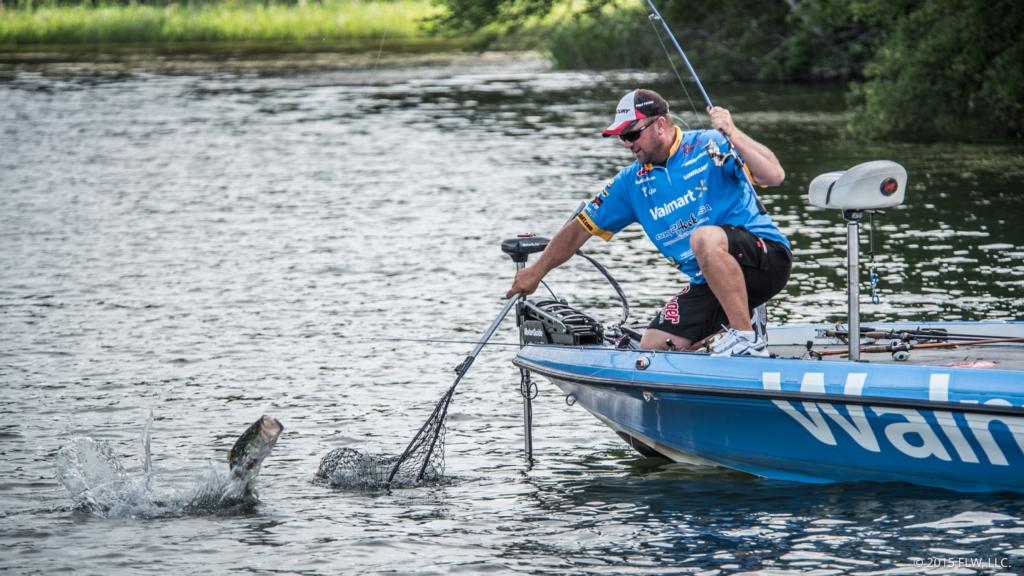
We all know this adage: There are always bass to be caught shallow.
Yet, in today’s world of ledge fishing, summertime is usually time to fish deep water, especially on the Tennessee River, and most especially if the goal is to catch bass big enough to claim a high finish at a major tournament.
Of course, “usually” doesn’t mean “always,” as Walmart pro David Dudley and Darrell Davis proved at last week’s Walmart FLW Tour event presented by Igloo Coolers on Lake Chickamauga.
While Michael Wooley was patching together an offshore pattern that ultimately gained him the win, Dudley and Davis climbed into the top 10 by fishing shallow water almost exclusively. Their results are worth a second look.
Dudley Fished “Anything that Looked Good”
The Lynchburg, Va., pro finished third with a four-day total of 85 pounds, 9 ounces. He says there wasn’t much science to how he caught his fish. Dudley’s biggest key was his commitment to start his search in shallow water in practice.
“Everybody knows that Chickamauga is loaded full [of big bass] in about a 10-mile stretch offshore,” Dudley says. “I had made up my mind last summer before we went there, when the schedule was announced, that I would not go deep if I didn’t have to. The first day of practice I went and established something shallow that I knew I could do to catch them. After that I started scanning deep because you never know if you’ll find a ‘Michael Wooley hole.’ That was my goal for the next two days.
“I found two [offshore] holes that I thought were kind of hidden,” he adds. “You always hope nobody finds them. One of them ended up with a lot of people on it. Terry Bolton found the other hole. Well, I can’t pull up on other people. I can’t do it. So I still fished deep some, but all 20 weigh-in fish were caught shallow.”
Dudley says he threw at anything and everything that looked good in front of him: a dock, some shade created by an overhanging tree, a stick-up, a bluegill bed, etc.
“The only pattern I kind of had going was bream beds, and I can’t remember how many I caught off a bream bed, but I’m going to say about five,” says Dudley, who claims he wasn’t exclusively hunting for bream beds, but would cast around one if he saw it.
Some of the bream beds he found were visible along the bank, but Dudley also found some deeper colonies of beds by scanning with electronics.
“The bream bed pattern was dying,” he adds. “The full moon was fading away. From the first day of practice to the last day of the tournament, it went from every bed [in a colony] had a bream on it to three-quarters of them to half to a quarter. If you pulled up to a colony of 20 beds, there would be five bream left by Sunday.”
Dudley spent the first couple of hours of each day in the same starting area. Then he ran a lot of new water that ranged from the shallowest banks in the backs of creeks to main-lake shorelines.
Three of his catches on the final day were captured on an iON camera. They showed Dudley hauling giants out from under docks with a wacky-rigged worm on spinning tackle. That rig also produced an 8-pound, 2-ounce bass that Dudley saw cruising the shoreline.
“She came cruising across the bream bed, and when I flipped the wacky worm over there, she was like, ‘Yeah, that’s what I want,’ and she ate it. And I was like, ‘All right,’” he recalls.
Other than that, Dudley didn’t encounter much of a “wolf pack” pattern. Nor was there much of a fishable bass spawn, as several pros predicted there would be before the tournament.
He caught fish on the wacky worm as well as a jig and a Texas rig and made it to the top 10 by finishing the tournament with three consecutive 20-pound-plus stringers.
Darrell Davis Targeted Bream Beds
Florida pro Darrell Davis moved into the top five in the Angler of the Year standings with his fourth-place finish at Chickamauga. Davis caught 77 pounds, 12 ounces over four days, but sub-20-pound days on Friday and Sunday kept him from threatening Wooley’s lead.
Davis was much more dialed in on a specific shallow pattern based on finding and fishing bream beds.
“Pretty much my plan was to fish shallow from the start,” he says. “I had a couple of deep spots that I did fish, but 90 percent of my time was shallow. I figured if I could find a shallow bite that I’d pretty much have it to myself. Once I got a couple of key bites during practice, I kind of just rode around and marked and found other areas.”
Davis fished bream beds on a mix of sandy bottoms, spawning spots close to laydowns, pockets within grass, subtle drop-offs just off the bank and more.
The best spots were in the backs of main-river pockets, but close to deep water, and Davis focused his search on the upper end of Chickamauga, working his way from takeoff toward Watts Bar Dam.
“It’s hard to explain exactly what to look for because every pocket was different,” he says. “Every area I fished had a different pattern. There were no two pockets that were the same.”
As the three official practice days wore on, Davis pieced together a milk run of 30 to 40 spots. In the tournament, he was able to run those waypoints in the mornings for the first two days. He changed it up in the afternoons and spent some of the later hours looking at new water to fish the next day. And by the end of the tournament, he was fishing new water exclusively.
In the grass, Davis swam a 1/4-ounce Revenge Baits Swim Jig with a Reaction Innovations Skinny Dipper trailer. Out deeper, he fan-cast a Texas-rigged Reaction Innovations Pocket Rocket worm to areas where he “just knew” the beds should be. Around shade, he tossed a floating frog.
Power-Poles and long casts were also important.
“I caught a couple of cruisers,” Davis says. “I had to cast way out in front of them and hope I didn’t spook them. Those shallow fish can’t take a lot of pressure. You have to be pretty stealthy with it. That’s one of the reasons I stayed with it; knowing I had it to myself. If there’d been a lot of people fishing shallow I’d have gone back deep.”
While prowling the shallows, Davis added a couple of bonus fish by flipping laydowns and duck blinds. In fact, his 6-pound kicker on day four ate a Reaction Innovations Sweet Beaver flipped to the remains of a duck blind. That fish helped Davis improve from seventh place to fourth on the final afternoon.
Still the bream beds provided the most consistent action.
“There’s always bass on them,” Davis says of bream beds. “If the bream are on the beds, there’s a big bass close by. It’s something I’ve done my whole life. You’ve got to have patience to get that bite. The only reason those fish are there is because the bream are there. What happens is that postspawn bass are leaving and moving out, the bream are on the way in and the bass just turn around and follow them back in as much as they can. You’ve got another month of that activity [on Chickamauga].
“Also, we were coming up on a new moon, and that keeps the bass active shallow during the daytime hours because there’s less [moon] light in the evening,” he adds. “The size of the bass and because I saw them cruising the beds was what made me stay on that pattern from practice through the tournament. I saw fish from 4 pounds all the way to double-digit bass cruising the beds.”
